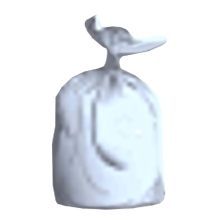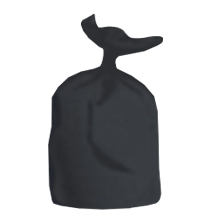The first known sighting of an Asian hornet (Vespa velutina) in Guernsey was in March 2017. Asian hornets have spread through Europe after arriving in Southern France in a consignment of pottery in 2004.
The Asian hornet is a non-native invasive species and an aggressive predator of many types of insect but on average 39% of its diet is made up of honeybees. The Asian hornet is therefore a major threat to our biodiversity, pollinating insects, and beekeeping activities.
The aim of the Asian Hornet Strategy is to ensure that we keep the population of Asian hornets as low as possible, to protect public health and the island's biodiversity. This strategy requires different phases of monitoring and capture throughout the spring and summer months, which are explained in further detail on this page, and require the participation of the general public alongside the work of the Asian Hornet Team.
Please note that Asian hornets are not to be confused with the Mandarin or giant Asian hornet (Vespa mandarinia) which is very much larger. The giant Asian hornet has not been found in the UK or Europe.
What do Asian hornets look like?
- Asian hornets have a distinctive velvety black/dark brown thorax. The abdomen is also black/brown with the abdominal segments bordered with a fine yellow band, only the fourth abdominal segment is almost entirely a yellow-orange. The legs are black/brown with yellow ends and the head is black with an orange-yellow face. A typical worker hornet is approximately 25mm (1 inch) in length. A queen is around 32mm (1¼ inch).
- For more information please see the "Asian hornet vs similar native species ID guide" sheet in the downloads section of this page. This document explains the differences between Asian hornets and other species native to Guernsey which often get mistaken for Asian hornets.
- There is further information about the biology and life cycle of the Asian hornet on the National Bee Unit website:https://www.nationalbeeunit.com/diseases-and-pests/asian-hornet/ .
Are Asian hornets dangerous?
- As with bees and wasps, the Asian hornet has a painful sting. The sting of an Asian hornet is no more harmful than that of a bee or wasp although if a person is allergic to bee or wasp stings they are also likely to react to the sting of an Asian hornet. However Asian hornets may act more aggressively than most other indigenous bee and wasp species if their nest is threatened so it is important not to deliberately provoke them. When foraging for food away from the nest the Asian hornet is no more aggressive than a normal wasp.
"Spring Queening" phase
- The Asian Hornet Strategy aims to keep the population of Asian hornets as low as possible. The first phase is a comprehensive island wide programme to trap queen Asian hornets as they emerge from hibernation, or travel across the water from France, in the spring - so called the "Spring Queening" project. Trapping these queens before they have the opportunity to raise their young and build huge nests will be the main priority. Specially modified traps are situated every 500m and selected householders and landowners have been asked to volunteer to put up and monitor a trap on their land. The same systematic method of trapping has been rolled out across Alderney, Herm and Sark.
- During this phase of the strategy, if you think you have found an Asian hornet, you are encouraged to trap it and take a photograph, if possible. The photograph should then be sent to the Asian Hornet Team along with the location of the sighting for confirmation. If the hornet has been trapped, a member of the Team will attend to collect the hornet.
- The Spring Queening phase typically runs from April - June, but the specific time frame is assessed each year. For more information please contact the Asian Hornet Team on tel: 07839 197082, or email asianhornet@gov.gg.
- Primary nests
- Early spring (April-May) is the time when Asian hornet queens emerge from hibernation and start to build their nests. These early nests are made exclusively by the queen and are sometimes called 'primary nests' as they are much smaller than the huge secondary nests made by worker hornets in the summer/autumn months.
- The primary nest starts off golf ball sized and soon grows to about the size of a small orange (2½ inches / 6 centimetres in diameter). They are pale brown in colour and made of papier mache which the queen makes by chewing wood and mixing it with water.
- If left undetected the solitary queen hornet continues laying eggs and feeding the larvae until she has raised a small brood of worker hornets, typically by the end of June. After this time the queen and her workers will normally relocate to build the large main nest, often high up in a tree.
- The Asian Hornet Team would like to ask members of the public to help them find these primary nests each spring. We ask that people check the ceilings of their outbuildings, sheds and porches in the hope of finding one of these early nests.
- Image on the left shows Asian hornet primary nest with queen Asian hornet. Image on the right is an Asian hornet primary nest.
"Track Don't Trample" phase
- The second phase of the Asian Hornet Strategy starts once the queen Asian hornets have left their primary nests along with their small brood of worker hornets to build the large main nest in a new location.
- These large nests expand rapidly during August - September and can hold up to 5,000 hornets. If left uncontrolled Asian hornets will present an increased risk to the public as well as causing significant harm to our native insect populations, such as bees, as they are voracious predators.
- To locate these main nests, members of the public are encouraged to "Track Don't Trample". During this phase, if you think you have spotted an Asian hornet, take a photograph if possible and take note of the direction the hornet travels in. By submitting this information the Asian Hornet Team will be able to track the worker hornet to reveal the location of the main nest. Once this nest is found the Team can arrange for the safe removal of the nest and the hornets within.
- Confirmed sightings from members of the public are vital to help us find nests and control the populations of Asian Hornets on Guernsey. It is not urgent that a nest is destroyed immediately, but it must remain undisturbed whilst the Asian Hornet Team make plans for its safe and efficient removal which often involves an experienced tree surgeon and a 'cherry picker' to access the nest. As autumn approaches it is important to destroy all of the nests before they have a chance to produce the next generation of queens which would otherwise hibernate and spread to other parts of the island the following spring. Do NOT attempt to remove a hornets nest as this is hazardous work requiring specialist PPE.
- Image shows Asian hornet secondary nest
What do I do if I think I've seen an Asian hornet?
- If you think you have seen an Asian hornet in the spring (March-June) please report it to the Asian hornet team immediately and provide a photograph if possible. If you find one indoors, please don't let it go as it will be a queen which we need to capture as part of the "Spring Queening" phase. You may be able to trap it against a window and put it under a glass. This is the time of year when small primary nests are often found on the ceilings of outbuildings, sheds and porches.
- In the summer and autumn months, worker hornets are busy looking for food to feed their young. We ask you not to kill it but take a photo and watch where it flies as the direction of travel may be helpful in locating a nest ("Track Don't Trample" phase). The large secondary nests are most commonly found high up in trees, although they may also be found lower down in brambles or in buildings.
- Please report the location of any insect or nest found to the Asian Hornet Team within Agriculture, Countryside & Land Management Services (ACLMS) by telephoning 07839 197082, or emailing asianhornet@gov.gg. Please don't kill any insects as there are many beneficial pollinators that are often misidentified as Asian hornets.
















